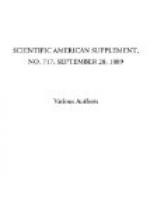Through the courtesy of our own Admiralty and of Messrs. Denny, of Dumbarton, the Italians have been permitted to avail themselves of the latest improvements which experience has suggested, and the construction of the special machinery and apparatus required has been executed by firms in this country having previous experience in this connection—Messrs. Kelso & Co., of Commerce Street, Glasgow; and Mr. Robert W. Munro, of London.
Having briefly traced the origin and development of the system of model experiment, it may now be of interest to describe the modus operandi of such experiments, and explain the way in which they are made applicable to actual ships. The models with which experiments are made in those establishments conducted on the lines instituted by Mr. Froude are made of paraffin wax, a material well adapted for the purpose, being easily worked, impervious to water, and yielding a fine smooth surface. Moreover, when done with, the models may be remelted for further use and all parings utilized. They are produced in the following manner: A mould is formed in clay by means of cross sections made somewhat larger than is actually required, this allowance being made to admit of the cutting and paring afterward required to bring the model to the correct point. Into this mould a core is placed, consisting of a light wooden framework covered with calico and coated with a thick solution of clay to make it impervious to the melted paraffin. This latter substance is run into the space between the core and the mould and allowed to cool. This space, forming the thickness of the model, is usually from 3/4 in. for a model of 10 ft. long to 11/4 in. and 11/2 in. for one of 16 ft. and 18 ft. long. When cold, the model is floated out of the mould by water pressure and placed bottom upward on the bed of a shaping machine, an ingenious piece of mechanism devised by the late Dr. Froude, to aid in reducing the rough casting to the accurate form. The bed of this machine, which travels automatically while the machine is in operation, can be raised or lowered to any desired level by adjusting screws. A plan of water lines of the vessel to be modeled is placed on a tablet geared to the machine, the travel of which is a function of the travel of the bed containing the model. With a pointer, which is connected by a system of levers to the cutting tools, the operator traces out the water lines upon the plan as the machine




